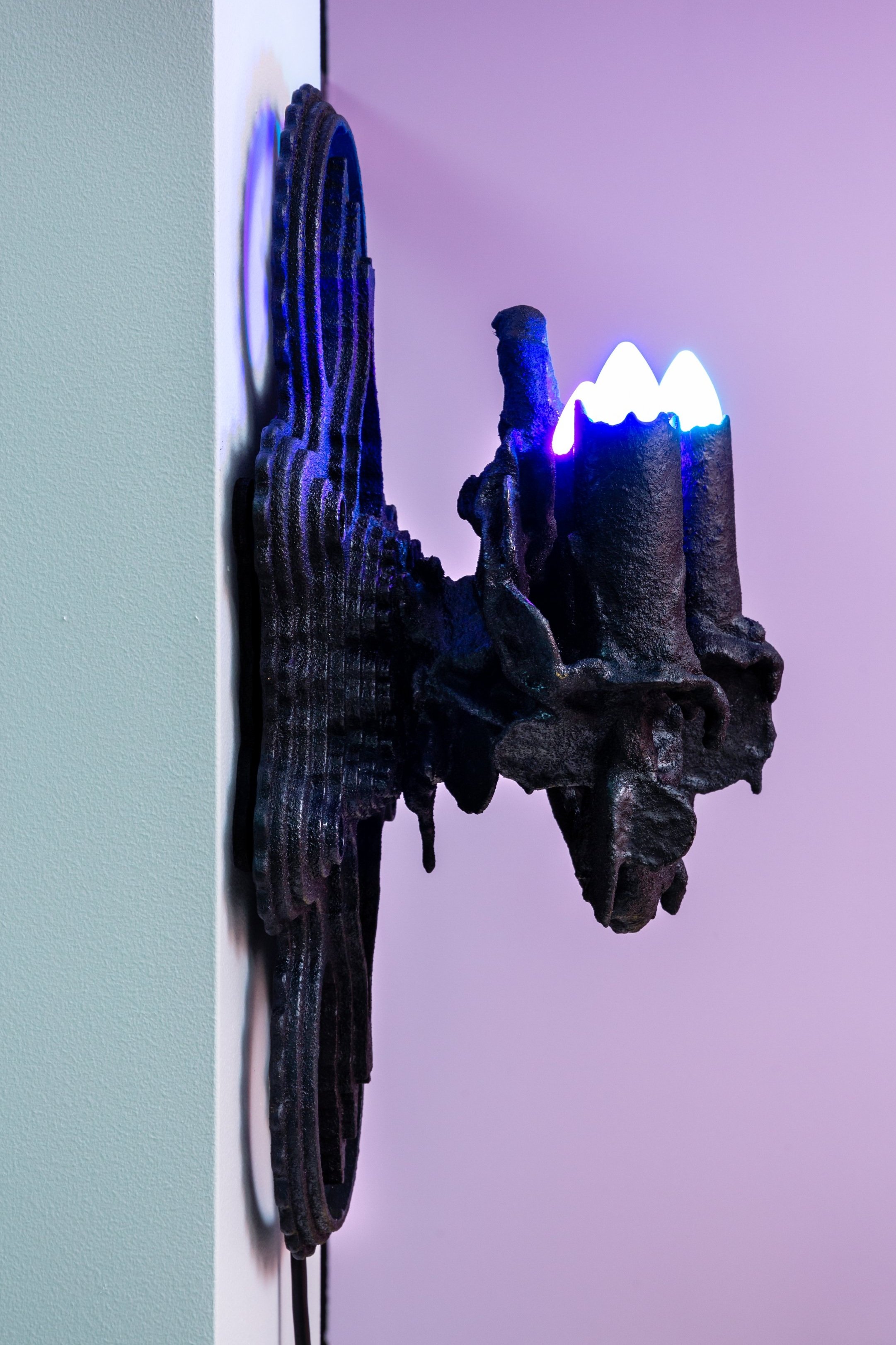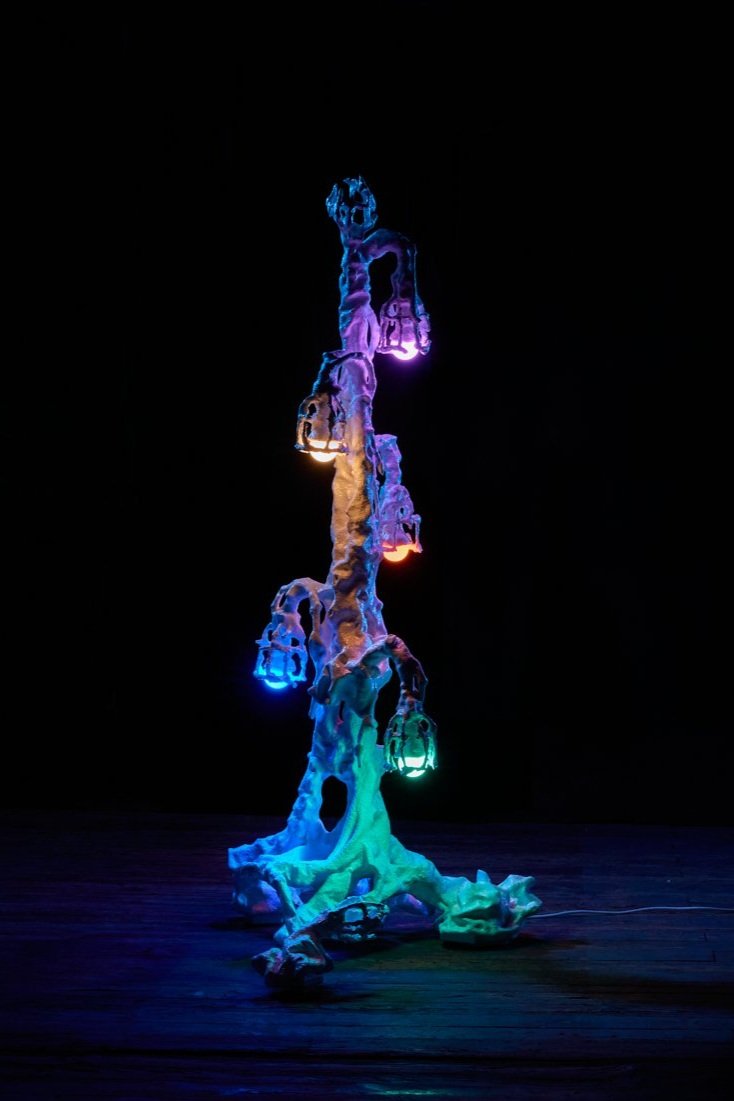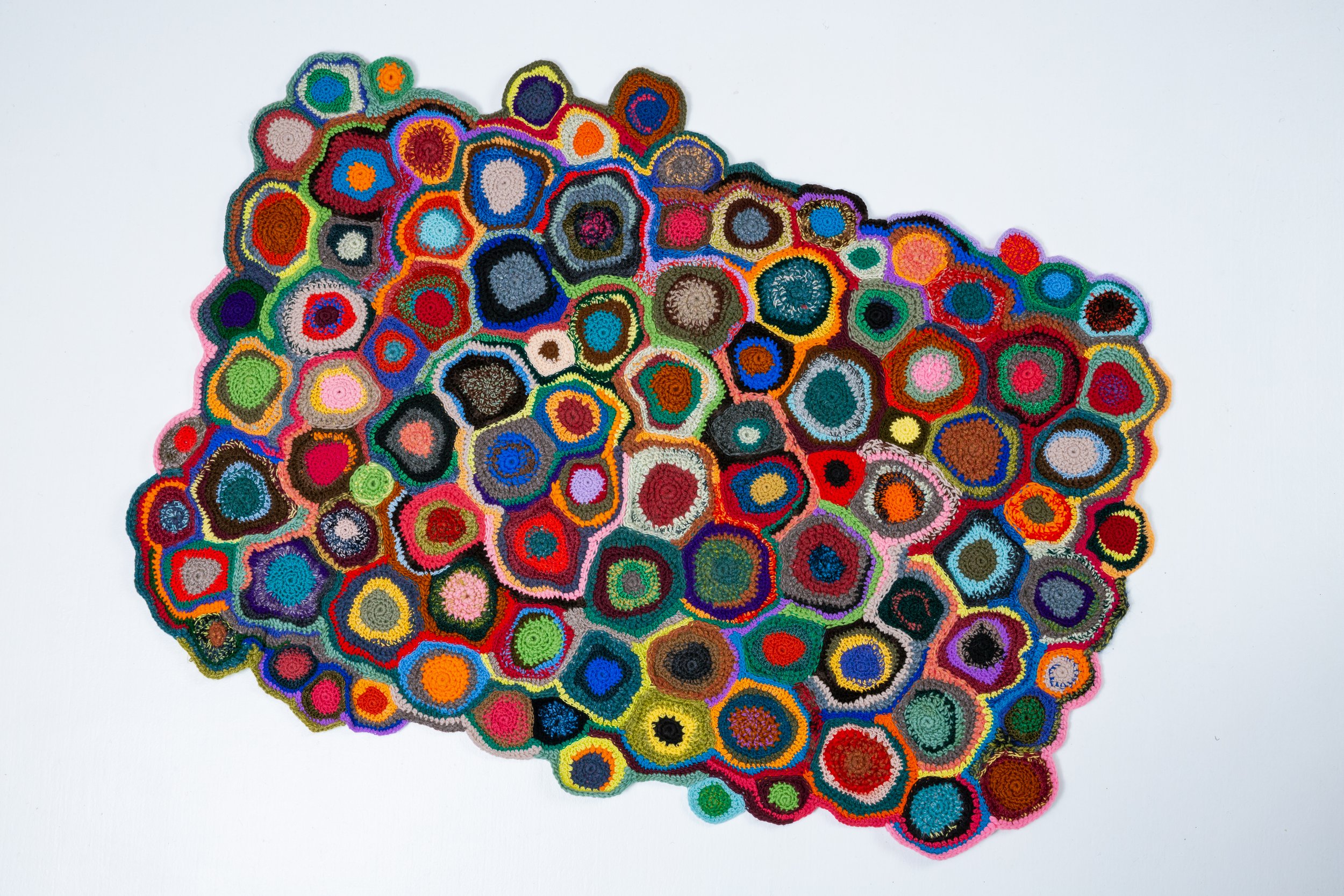Exhibitions
Isolated from Function
Aaron Blendowski & Sue Ravitz
February 4 - March 20, 2022
Exterior view of installation
(Photo credit: Brian W. Ferry)
Isolated from Function brings together, for the first time, two artists with extraordinary senses of color, Aaron Blendowski and Sue Ravitz.
Both seek to juxtapose traditional domestic forms and analog methods of making with darkly vibrant, and at times challenging, color combinations. The artists chose six pieces each to contextualize the other’s work, in turn creating an otherworldly environment that blends historical crafts with futuristic aesthetics.
While the show’s title emphasizes the detachment of the works on view from the domestic space and the function they serve within that space, the furniture, lighting and textiles emphasize time as much as isolation. Both artists utilize various mediums – fiber, resin, wood and color – to explore our past, present, and potential future.
The six works on display by Sue Ravitz showcase the breadth of her fiber art, influenced by an early exposure to traditional handicrafts while growing up in the Midwest. Although generations of women in her family crafted, Ravitz was never exposed to art with a capital A. After moving to New York City, she began exploring color more seriously, both in her own practice and through her collecting (she and her husband, an artist in his own right, have amassed an extensive collection of Monochrome and Reductive abstract art). Later, she combined the influences of her upbringing with the art that surrounds her to create an art practice focused on color relationships, investigated through natural fibers.
Installation view
(Photo credit: Brian W. Ferry)
A prime example is her hand-dyed, braided wool rug, which is an explosion of color, and forms the focal point of the exhibition. While braided rugs have been a staple of American domestic crafts since the early part of the nineteenth century, Ravitz contemporised the palette for her Isolated from Function centerpiece. Early rug braiders used whatever fabric they could spare and, necessarily, could not pay close attention to color relationships or even material, as examples exist that mix linen, wool and velvet. Ravitz’s rug, on the other hand, employs traditional technique, but achieves a contemporary, kaleidoscopic effect. To achieve this, Ravitz stitches long strips of hand-dyed woolen fabric together that she then painstakingly assembles to create unexpected color relationships, such as earthy greens and browns with neon yellows and pinks. She then braids the strips, coiling the resulting plaits into circular patterns reminiscent of Shaker “Spirit” rugs – intuitive rugs in which the pattern and color combinations were derived more from the makers’ mood than any predetermined plan. Ravitz therefore is able to bridge time, from the long tradition of women homemakers in early America to today, all with a sense of newness, vigor and authenticity.
Installation view
(Photo credit: Brian W. Ferry)
In addition to the central rug, Ravitz selected works that use traditional handicrafts, but with subversive twists. Her silk needlepoint panels, for example, employ a pattern that resembles television static, a common sight in the past, but something contemporary viewers rarely experience with today’s digital technology. Staring at one of these panels is like staring into an analog screen, absent of a signal, in which the black and white pixels are replaced by the full color spectrum. While the pattern may be frozen in place, the color relationships and luminous silk thread make the panels vibrate.
Rounding off her presentation are a vibrant chain stitch sampler and a richly colored and patterned crochet wool blanket, reinforcing to viewers her prowess with natural fibers and handicraft techniques.
Installation view
(Photo credit: Brian W. Ferry)
Another Midwestener, Aaron Blendowski grew up in the Michigan countryside. Much like Sue, he chose to move to the city, in his case, Detroit. Through teaching at his Graduate alma mater Cranbrook and toiling in his studio in the city’s Eastern Market neighborhood, he has been embedded in the city’s fabric ever since. He has developed a series of works that vary in appearance, but all play with a sense of nostalgia for the past or foreshadowing our future.
One body of work on view in Isolated from Function is his NEO series. This oeuvre focuses on a playful reimagining of familiar, and sometimes archaic, forms. For example, Winzer Chair updates the Windsor-style chair, common in America starting in the first quarter of the nineteenth century to the mid-twentieth. Radical for the time, Windsors opted for socketing spindles into a central plank seat that then formed the back, arm rests and legs instead of the more refined mortise and tenon joints; this shift had more in common with industrial wheel production than fine furniture. Blendowski embellished his version with hand-carved elements that resemble 3D topographical maps, botanical forms and dripping candle wax. Interestingly, the earliest Windsor chairs were painted green, with the paint being lost to time as new generations repainted or refinished the originals to match prevailing tastes. So, Blendowski, whose interpretation is also green, at once looks to the future, while being rooted in the past.
Detail view of Winzer Chair
(Photo credit: Brian W. Ferry)
Button Pub Chair is another work from NEO that takes on a familiar archetype – the pub, or captain’s chair. Here Blendowski’s exuberance shines. The seat is in the shape of a larger-than-life button, hand-carved on a lathe to create the perfect illusion. Blendowski references the long tradition of painted furniture by purposely leaving brush strokes of orange paint against the stained wood grain. Blendowski’s vessel continues the reimagining of domestic models. With Hollow Urn Blendowski takes the decorative pedestaled vessel to imaginative heights by defining the form with flat planes of mild steel, finished with zinc to create a luminous, iridescent surface.
Installation view
(Photo credit: Brian W. Ferry)
Detail view of Button Pub Chair
(Photo credit: Brian W. Ferry)
Detail view of Tree from the Last Resort (Silica Tower) floor lamp
(Photo credit: Brian W. Ferry)
Whereas NEO reinterprets the past, Blendowski’s Voyager body of work looks to the future. This is where the technical sophistication of his industrial design training and the expressive quality of his sculpture background meet. Traditional forms, such as a wall mirror, floor lamp and sconce, are rendered at a monumental scale. Blendowski wants the works to look as though they were assembled from materials salvaged after some apocalyptic event. Our future home could be illuminated by a seven foot tall floor lamp, with color-changing bulbs, as with Tree from the Last Resort (Silica Tower), or maybe it's lit by a candelabra, dredged from some tar-like pool, bolted with found machinery, as shown in Trinity Shadow Candelabra (Silica Growth).
Detail view of Trinity Shadow Candelabra (Silica Growth)
(Photo credit: Brian W. Ferry)
Looking into Blendowski’s wall mirror completes the futuristic fantasy. The mirror backing of From The Dark ( Sublime Viewfinder) is purple, not silvered, which creates an otherworldly, ever-so-slightly distorted image looking back at the viewer.
When viewed independently, each artist’s body of work seems worlds apart. However, by placing their work in context with one another, we see similarities and synergies. There are formal parallels: the scalloped edge of Ravitz’s crochet throw blanket is mirrored in the intricate sides of Blendowski’s Hollow Urn or the graceful border of Ravitz’s braided rug echoes the curve of the hand-carved armrest of Blendowski’s Winzer Chair. There are also thematic ones: both artists are playing with color to express their view on time. While in the glass cube-like gallery space the works may be removed from their intended purpose, the mix of familiar historical references, contemporary palettes and eerie flourishes are simultaneously comforting and discomfiting.
Stephen Markos
Founder, Superhouse
Installation view
(Photo credit: Brian W. Ferry)
Aaron Blendowski Button Pub Chair
Aaron Blendowski Winzer Chair
Aaron Blendowski Tree from the Last Resort (Silica Tower) floor lamp
Aaron Blendowski Trinity Shadow Candelabra (Silica Growth) wall lamp
Aaron Blendowski Hollow Urn vessel
Aaron Blendowski From The Dark (Sublime Viewfinder) mirror
Sue Ravitz TV Stastic (Red, Blue, Yellow) needlepoint wall panels
Sue Ravitz Braided Rug
Sue Ravitz Throw Blanket
About Aaron Blendowski
Aaron Blendowski received a BFA from College for Creative Studies and an MFA from Cranbrook Academy of Art. At his studio in Detroit’s Eastern Market, he produces work that ranges from functional sculpture and furniture to two-dimensional graphics. The growth and diversity of his city informs larger existential questions raised in his work. Blendowski utilizes his training as a sculptor and an industrial designer to experiment with materials, sometimes focusing on their purity and sometimes transforming them as far as he can from their original state. Blendowski has shown work with Cranbrook Art Museum (Bloomfield Hills, MI), Atlanta Contemporary (Atlanta, GA), In Good Company (Brooklyn, NY), Wasserman Projects (Detroit, MI) and Superhouse (New York, NY). His work has been featured in numerous publications, including Damn, Design Milk, Document Journal, Elle Decor Italia, Interior Design, Paper, Sight Unseen and The Design Edit. Blendowski lives and works in Detroit, Michigan.
About Sue Ravitz
Sue Ravitz grew up a small-town girl, in Kalamazoo, Michigan. For generations, the women in her family did crafts. While she began doing handicrafts at an early age, she was never exposed to “fine art.” She continued her practice while raising her family in Chicago, Illinois. When her children left home, she began to explore color more seriously. She spent hours every day knitting small blocks of patterns, spreading them out on the floor, and considering how they related to each other. During this time, she and her husband actively collected art, primarily reductive, monochrome paintings – all surface and color. After moving to New York, New York in 2006, Ravitz began making rugs. She continues to braid, hook, crochet, and stitch, but her focus remains primarily on color interaction, no matter the medium. Ravitz had a solo presentation of her rugs and paintings at Mondo Cane Gallery (New York, NY) – now Patrick Parrish – and showed her needlework in a group exhibition at Minus Space (Brooklyn, NY). From 2020 – 2021, Ravitz curated, and then published, Painting on Porch, a series and book of paintings paired with her furniture collection and installed on the porch of her Connecticut farmhouse. Ravitz also directs and curates the program at 57W57ARTS. The artist lives and works in Wilton, Connecticut.
Detail view of Braided Rug
(Photo credit: Brian W. Ferry)





















